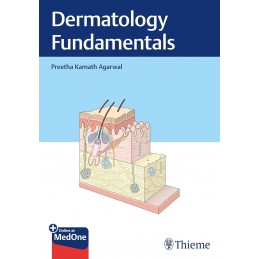- Obniżka
- Nowy


 Dostawa
Dostawa
Wybierz Paczkomat Inpost, Orlen Paczkę, DHL, DPD, Pocztę, email (dla ebooków). Kliknij po więcej
 Płatność
Płatność
Zapłać szybkim przelewem, kartą płatniczą lub za pobraniem. Kliknij po więcej szczegółów
 Zwroty
Zwroty
Jeżeli jesteś konsumentem możesz zwrócić towar w ciągu 14 dni*. Kliknij po więcej szczegółów
Pocket-friendly guide enables navigating the essentials of dermatology with ease
From the intricate details of skin pathology to the latest in medical advancements, the breadth of dermatologic information can be overwhelming, especially for those in training or early-stage careers. Dermatology Fundamentals, edited by double board-certified dermatologist and Mohs surgeon Preetha Kamath Agarwal reflects a unique blend of clinical expertise, academic rigor, and teaching experience from a myriad of esteemed contributors. It is designed to help readers quickly recall key information during a busy clinic day, prepare for exams, and solidify foundational knowledge.
The book starts with insights on preclinical years, most notably how to match into a dermatology residency—a competitive and challenging process. It concludes with career path pearls, including discussion of fellowships, mentorship, practice models, and fundamentals of coding. Reader-friendly chapters also cover basic science, general and complex medical dermatology, pharmacology, dermoscopy and dermatopathology, surgical dermatology, cosmetic dermatology, and pediatric conditions.
Key Highlights
- Provides a concise and quick dermatologic reference, from board exam preparation to bedside consultations
- Meets the needs of all-level learners, with high-yield insights and knowledge to excel in exams and patient care
- Covers must-know dermatology topics in an easy-to-digest pocket format
This is an indispensable, on-the-go reference for medical students, dermatology residents, and practitioners in both academic and clinical settings.
Opis
Part I: Introduction to Dermatology
1. Advice for Preclinical and Postclinical Years
2. Tips for a Successful Match
Part II: Basic Principles and Background
3. Overview of Basic Science
4. Skin, Hair, and Nail Anatomy and Physiology
5. Common Dermatologic Workups, Differentials, and Orders
Part III: General and Complex Medical Dermatology
6. Papulosquamous Disorders
7. Approach to Eczematous Disorders
8. Vesiculobullous Disorders
9. Lichenoid and Interface Dermatoses
10. More Than Meets the Eye: A Closer Look at Urticarias and Erythemas
11. Purpuras and Vasculitis/Vasculopathy
12. Adnexal and Pigmentary Disorders of Skin
13. Neutrophilic, Eosinophilic, and Pregnancy Dermatoses
14. Granulomatous and Histiocytic Disease
15. Cutaneous Manifestations of Connective Tissue Disorders
16. Understanding Fibrosis: The Pathophysiology of Sclerosing Skin Disorders
17. Metabolic Health and Dermatology: Interpreting Cutaneous Signals
18. Beneath the Skin: Exploring Systemic Diseases through Dermatological Symptoms
19. Dermal Connective Tissue Disorders
20. Infectious Disorders
21. Neurocutaneous Disorders
22. Cutaneous Manifestations of Physical Agents, Insults, and Injuries
23. Hair and Nail Disorders
24. Mucosal Disorders
25. Cutaneous Manifestations of Internal Diseases
Part IV: Pharmacology
26. Pharmacology
27. UV Therapies in Dermatology
Part V: Dermoscopy and Dermatopathology
28. Dermoscopy Algorithms
29. How to Use a Microscope and Essential Dermatopathology Terminology/Concepts
30. High-Yield Dermatopathology Differentials by Histologic Category
Part VI: Surgical Dermatology
31. Fundamental Anatomy
32. Facial Danger Zones
33. Anesthesia
34. Suture Properties
35. Surgical Instruments
36. Neoplastic Dermatology Pathways
37. Nonsurgical Options for Nonmelanoma Skin Cancers
38. Biopsy Excision and Techniques
39. Mohs Micrographic Surgery, Flaps, and Grafts
40. Nail Anatomy and Surgery
41. Dressings, Wound Care, and Scar Improvement
42. Surgical Complications
43. Oncologic Agents in Dermatology for Melanoma and Nonmelanoma Skin Cancers
Part VII: Cosmetic Dermatology
44. Aging and Photoaging .
45. Neurotoxin
46. Soft Tissue Fillers
47. Lasers and Other Energy-Based Technologies
48. Laser Endpoints
49. Sclerotherapy and Treatment of Leg Veins
50. Liposuction and Fat Reduction
51. Hair Transplantation
Part VIII: Pediatric Dermatology
52. Cutaneous Eruptions of the Newborn
53. Genodermatoses/Inherited Disorders of Pigmentation
54. Genodermatoses/Inherited Disorders of Connective Tissue
55. Inherited Disorders of Metabolic/Nutritional and Autoinflammatory Disorders
56. Vascular Tumors and Malformations
57. Neurocutaneous Syndromes and Tumor Syndromes
58. Primary Immunodeficiency Disorders and Premature Aging Syndromes
59. Viral Exanthems and Infectious Diseases of Childhood
60. Disorders of Cornification
61. Epidermolysis Bullosa and Other Pediatric Rashes
Part IX: Career Paths and Billing/Coding
62. Dermatology Fundamentals: Dermatology Fellowships
63. Career Paths and Mentorship
64. Choosing Which Practice Model to Work In
65. Fundamentals of Billing and Coding
Index
